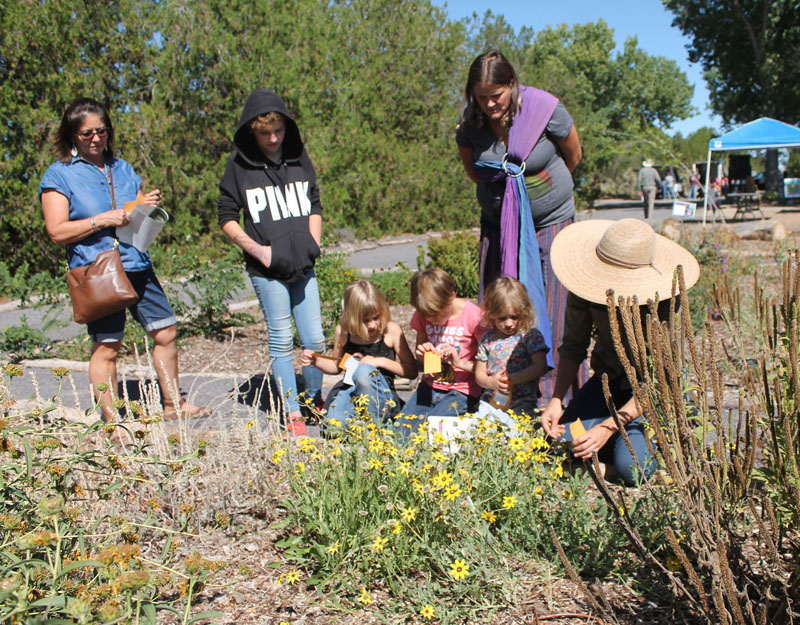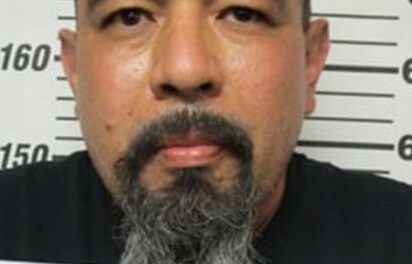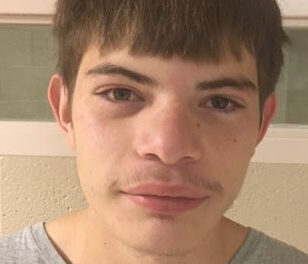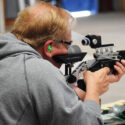LOS LUNAS—About 200 people went to the Los Lunas Science Center last Saturday to check out the first ever Rio Grande Heritage Festival.
With everything from edible native plants to gourd art, corn husk dolls and sheep shearing, the festival was a celebration of the agricultural life in the Middle Rio Grande Valley.
Alissa Freeman, senior program specialist and director of the pollinator-friendly learning garden at New Mexico State University, along with Dr. Marisa Thompson, NMSU extension horticulture specialist, were on hand to explain native seed harvesting to visitors.
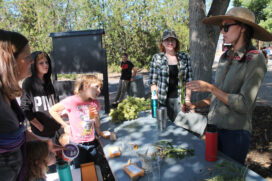
Alissa Freeman, senior program specialist and director of the pollinator-friendly garden at New Mexico State University, tells a family about the different kinds of native plant seeds that can be harvested in the fall.
There were cone flowers, verbena and even “chocolate” flowers, which permeated the air with their sweet candy smell, in the seed garden. Visitors to the festival wandered from plant to plant with small manila envelopes, gathering seeds to spread this fall and enjoy in the spring.
Shasta Murillo, of Belen, brought her four children to the festival.
“We home-school them and have a small family farm, so this is right up our alley,” Murillo said.
She said her children were interested in gardening and flowers, and wanted to do something for pollinators, especially butterflies.
“It’s all about the butterflies,” she said, laughing.
While the seed harvesting area was quiet and verdant, local blacksmith Robert Ulibarri raised a clatter with his hammer and hot steel as he banged out a matching pair of horse shoes.
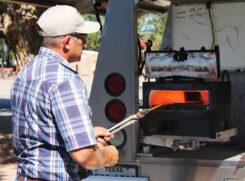
Blacksmith Robert Ulibarri heats a length of metal in his portable forge which will be beaten and shaped into a horse shoe. Ulibarri was one of nearly two dozen demonstrators out at the first ever Rio Grande Heritage Festival, held at the NMSU Agricultural Science Center in Los Lunas last Saturday morning.
Ulibarri, a Belen High School and NMSU graduate, said coming to events like the Heritage Festival gives him an opportunity to educate and give back.
“You have to make time to educate and assist, especially in the agricultural community,” Ulibarri said. “It’s good to know how things are made by hand, to learn about hand tools. The more you know about how something is done, the better you are at it.”
As a farrier, Ulibarri uses a lot of “keg” shoes, which are pre-made by a machine. That doesn’t always work for all horses, he said.
“Sometimes you have a horse that has a health issue so you need to know how to make shoes,” he said.
Ulibarri also uses horse shoes to create small metal sculptures and turns raw metal bars into pointy-hatted wizards on occasion.
“Metal working has always been something that interested me,” he said.
After three decades, Anthony Cordova can shear a sheep in mere minutes, removing its fleece in one large piece.
He starts by removing the belly wool, which on the black and white face crosses he had at the festival isn’t attached to the rest of the fleece.
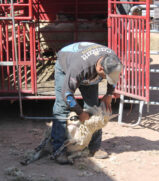
Anthony Cordova, a sheep shearer for 30 years, removes the wool from a sheep during a demonstration at the Rio Grande Heritage Festival last Saturday.
Then Cordova sits them up on their haunches, and with long, continuous strokes of the clippers, moves seamlessly down their neck and across their body, down their legs and then repeats the process on the other side.
The shearing doesn’t hurt the animals and is typically done once a year.
“When they are sheared, they usually do what’s called tagging, where the wool on their face and around their udders is cleaned up,” Cordova said.
Over at the seed separator, Dennis Price fed stalks of rye into the machine, getting rid of the “junk” to collect the seeds that would later be ground for bread.
Price said events at the science center, like the festival, are all about educating the public.
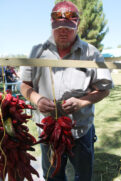
Using a simple half hitch and a lot of red chiles, Chuck Havlik demonstrates how to make a ristra.
“It’s what our field days are all about. It’s nice to get the community together,” Price said. “We need to educate the younger generation, especially since we are seeing less farming.”
Many of the demonstration stations focused on the end result of agriculture — food. Green chile cheeseburgers were served for lunch, along with a side of sweet corn dunked in melted butter. Both the chile and corn were grown at the Los Lunas Agricultural Science Center. For dessert was fresh fruit cobbler made in a Dutch oven.
Kiane Garcia, with the Valencia County Farm and Livestock Bureau, said while the semi lost art of Dutch oven cooking can take time, it’s very straight forward.
“The recipe for the fruit cobbler is so simple, it should be a crime,” Garcia said with a laugh.
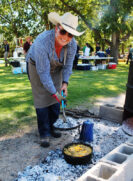
Kiane Garcia with the Valencia County Farm and Livestock Bureau shows off a bubbling hot peach cobbler made fresh that morning in a Dutch oven at the Rio Grande Heritage Festival.
Mix a box of yellow cake mix with a can of fruit of your choice, add cinnamon and sugar, mix well and bake on hot coals for about an hour to and hour-and-a-half, and out comes an ooey, gooey treat.
The coals take about an hour to prepare, Garcia, but once they’re ready and have been piled on top of the cast iron oven, the dish takes care of itself.
Relaxing in the shade on some hay bales, Sean Simmons-Hogan, Crystal Vigil and Charlie Hogan all said they enjoyed the event.
Simmons-Hogan has a small flock of goats in Tome and came out to the center for the Forage Field Day, which ran concurrently with the festival.
“I got some really good tips on how to improve pasture I already have and new things to add,” Simmons-Hogan said. “They talked a lot about teff grass.”
Teff grass is a summer annual forage for livestock and commercial hay producers that is native to the Horn of Africa.
The crafts, such as the weaving, corn husk dolls and colchera embroidery, were Vigil’s main focus, while Hogan was actually a volunteer for the morning, assisting attendees with parking.
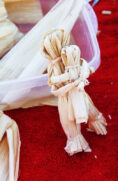
Using what is available, rural families would often make dolls for children from dried corn husks.
A master gardener himself through the New Mexico State University’s Valencia County Cooperative Extension Service, Hogan said he was interested in everything presented that day.
“I managed to get to everything — I got the spaghetti sauce and bean soup recipes,” Hogan said. “I have a bit of a garden, so I can and freeze.”
Before the festival wrapped up, a couple of the Dahl sheep there on display for the day made a break for it, loping slowly through the lunch crowd, reminding everyone just what the rural, agricultural life is really like.
Julia M. Dendinger began working at the VCNB in 2006. She covers Valencia County government, Belen Consolidated Schools and the village of Bosque Farms. She is a member of the Society of Professional Journalists Rio Grande chapter’s board of directors.
